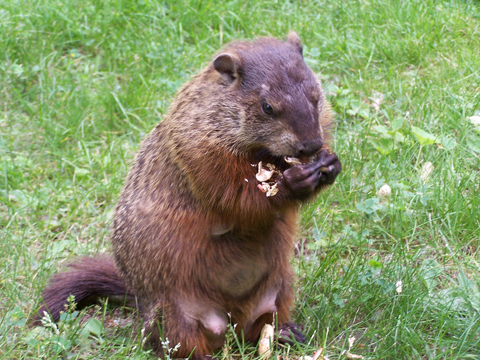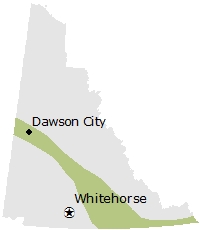
Name
- Common name: Woodchuck
- Scientific name: Marmota monax
- Order: Rodentia
- Family: Sciuridae
Also known as
Groundhog, Whistle Pig
Viewing opportunities
- Woodchucks have only been spotted in the southeastern parts of the Yukon around the BC border, near Watson Lake, Labiche River valley and on the South Canol road.
Report sightings of Woodchuck
The Yukon distribution of this rodent is poorly understood. Voluntarily report your observations to the Yukon Conservation Data Centre.
Description
- Medium sized rodent with short legs, stocky body, small ears.
- Brownish with grizzled hair appearance.
- Prominent slightly flattened bushy tail.
Fast facts
- Length: 55 cm
- Weight: 4 kg
- Lifespan: 6 years
- Predators: Wolves, Coyotes, foxes, bears, large hawks and dogs
- Habitat: Boreal Forest, South-facing slopes
Conservation status
- Yukon: S2S3 (Imperiled/vulnerable)
- Global: G5 (Secure)
Yukon population estimate
Not determined.
Behaviour
Woodchucks use powerful digging claws to excavate burrows. When alarmed, they use a high-pitched whistle to warn the rest of the colony, hence the name "whistle-pig." They escape predators by diving into their burrows, but may also swim or climb trees. Woodchucks are fat-storing hibernators, meaning they live off of their fat reserves while sleeping the winter away.
Diet
Grass, leaves, seeds, berries, bark, carrion
Distribution

Sights and sounds

Woodchuck track, hind: 5.4 cm long.
Woodchucks and people
- Woodchucks are a major hole-digging mammal, providing homes and burrows for other animals.
- Farmers do not appreciate the hole-digging capabilities of Woodchucks, as it can lead to crop damage and loss of vegetables from the garden.
- Because they are fat-storing hibernators, Woodchuck are the subjects of a great deal of medical research.
- On February 2, North Americans observe “Groundhog Day.” Folklore tells us that Woodchucks (Groundhogs) will emerge from their winter sleep and come out of their dens. If it sees its shadow, it will return to its den and we will have 6 more weeks of winter. If not, then spring is coming soon.